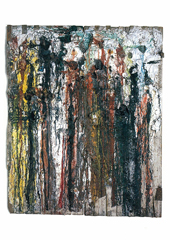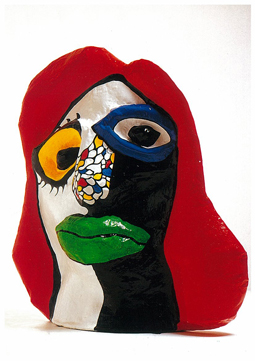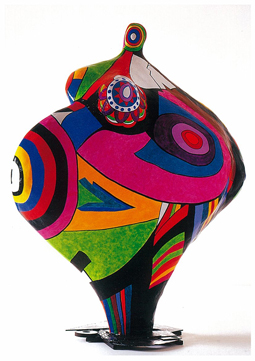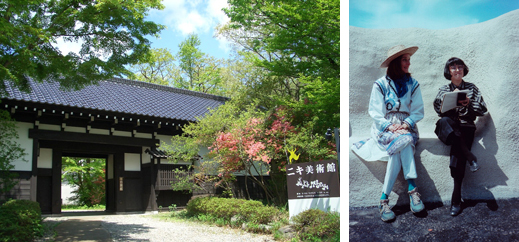 |
|
Here and There introduces art, artists, galleries and museums around Japan that non-Japanese readers and first-time visitors may find of particular interest. The writer claims no art expertise, just a subjective viewpoint acquired over many years' residence in Japan.
|
|
 |
|
|
 |
 |
Nanas in Nasu: The Art of Niki de Saint Phalle
Alan Gleason |
 |
 |
|
 |
| Niki de Saint Phalle, "Tir (Shooting)" (1961); wood, plaster of paris, miscellaneous objects, dripping by shot; 195�~159 cm. |
|
Niki de Saint Phalle, "Une des Premieres Nana en Laine" (1965); papier-mache, wool, resin; 75�~92�~75 cm. |
Nasu, a highland resort area 150 kilometers north of Tokyo, is known for its woodsy terrain, cool breezes, and boiling hot springs (it lies on the slopes of a live volcano). It is also the location of a unique museum dedicated to the work of a French-American artist, the late Niki de Saint Phalle. Sadly, Nasu will not be home to this remarkable institution for much longer.
The Niki Museum is the brainchild of Yoko Masuda, a devout fan of the artist. Masuda fell in love with Niki's work after seeing one of her paintings at a Tokyo gallery in 1980. Masuda (who died earlier this year) began a correspondence with Niki that would continue until the artist's death in 2002, and along the way acquired an impressive collection of her paintings and sculptures. In 1981 Masuda opened her own Tokyo gallery, Space Niki, but when this became too small to hold her burgeoning collection, she began looking for land on which to build a museum, and settled on a lovely spot in the Nasu forest. The Niki Museum opened in 1994 on the grounds of a former summer estate, replete with old wooden gate, formal Japanese garden, and gurgling mountain brook. Now, after only fifteen years in operation, it will close its doors at the end of August 2009.
Raised in New York by a French father and an American mother, Niki de Saint Phalle earned some notoriety in the early sixties with her angry "shooting" paintings, created by firing rifle bullets at a surface covered with plaster-encased bags of paint. But she soon moved on to massive papier-mache (and later polyester and polyurethane) sculptures of what Niki called her "Nanas": plump, vibrant, earth-motherly effigies of women. One of the first and biggest, "Hon" ("She" in Swedish), was 28 meters long and could be entered through a door between the reclining Nana's thighs. These gargantuan works, colorful, erotic and life-affirming, can be found in places as scattered as Paris's Pompidou Center, the University of California at San Diego, and the vast Tarot Garden of outdoor sculpture designed by Niki herself in Tuscany, Italy.
Masuda's dream was to build something similar to the Tarot Garden in Nasu. Unfortunately Nasu is situated in a national park with strict zoning regulations, and outdoor statuary -- at least the type associated with Niki -- was not permitted. Nor was the artist's original building design, which was as bulbous and colorful as her sculptures. To accommodate the local laws, Masuda and her husband, a retired department store chairman who served as planning director for the museum, settled instead on a starkly angular concrete structure with large windows to offset the luscious curves and colors of the works displayed inside, while drawing in the light and the green beauty of the surrounding forest. This compromise proved so successful that the building won the Tokyo Architectural Prize for Excellence in 1996.
The interior layout leads the visitor through a series of corridors and rooms in a zigzag sequence inspired by the snake imagery that pervades much of Niki's work. These spaces are filled with Nanas as well as paintings in which words share equal weight with pictures. A special exhibit details the history of the remarkable friendship between the artist and her devoted Japanese patron.
The impending close of the Niki Museum borders on tragedy, though staff aver that a new site (probably smaller, but more convenient to downtown Tokyo) is under study and that the collection should have a new home in a year or two. It does not seem likely, however, that even the new location will permit the outdoor display that Niki's huge, playfully organic sculptures rightfully deserve. To see them in their natural habitat, a trip to the Tarot Garden in Tuscany is recommended.
Still, visitors and Kanto residents will not regret a day trip (or better yet, an overnight one to allow a leisurely soak in one of the many nearby hot springs) to enjoy the stunning collection amassed by Masuda while it remains in Nasu. Though the museum explains the closure in terms of the need for a less isolated venue, one cannot help but think that it has something to do with Masuda's recent passing.
The Niki Museum is still there in its idyllic mountain setting for another month. If you are in Japan this August, go.
 |
|
 |
| Niki de Saint Phalle, "Big Head" (1970); polyester, lacquer paint; 245�~223�~100 cm. |
|
Niki de Saint Phalle, "Gwendolyn" (1966-1990); polyester, polyurethane paint, iron base; 262�~125�~200 cm. |
|
 |
| The nagaya-mon entrance to the Niki Museum, an old gate preserved from the original estate on which it was built. |
|
Niki de Saint Phalle and Yoko Masuda sitting in the Tarot Garden, Tuscany, in 1983.
All images by permission of the Niki Charitable Art Foundation (NCAF) and the Niki Museum, Nasu, Japan. |
|
|
|
|
|
 |
|
 |
|
 |
Niki Museum |
 |
|
|
(Note: The museum will close its Nasu site permanently on 31 August 2009 pending a move to a new location.)
Yumoto, Nasu-machi, Nasu, Tochigi Prefecture
Phone: 0287-76-2322
Hours: 9:30-5:00 (closed Wednesdays)
Transportation: Take the Tohoku Shinkansen train to Nasu-Shiobara (80 minutes from Tokyo), board a Toya Bus for Nasu-Yumoto, and get off at Shin-Nasu (a 15-minute ride from the station). The museum is a 5-minute walk from the bus stop. |
 |
|
|
 |
 |
Alan Gleason
Alan Gleason is a translator, editor and writer based in Tokyo, where he has lived for 25 years. In addition to writing about the Japanese art scene he has edited and translated works on Japanese theater (from kabuki to the avant-garde) and music (both traditional and contemporary). |
|
|
|
 |
 |
|